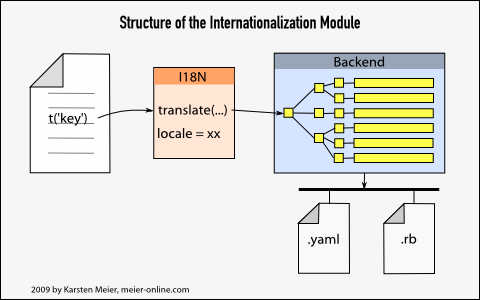Sorry, this entry is only available in German.
Multilingual Websites with Ruby on Rails (2)
Part 2 – Variables, Validations, Model Classes
Web pages often contains sentences in which a single word is changing. For example, “You are logged in as xxxx.” For the translation, we can obviously assemble the sentence from the components. There is often a problem, because the order of the words is different in different languages .
A better solution is the so-called interpolation, as Ruby itself also offers. The string contains a marked variable, which will be replaced at run time. The Yaml file specification does not use the Ruby syntax. Instead, you mark the variable with double curly brackets.
# Definition logmsg: "You are logged in as {{name}}." # call I18n.translate(:logmsg, :name => 'Administrator') # or short form t :logmsg, :name => 'Administrator' |
Continue reading “Multilingual Websites with Ruby on Rails (2)”
SQL: Set a Field from a linked Table
A little hack for the Joomla Community Builder
Recently, I received a job request. An existing web application will be greatly expanded, and therfore converted to use the CMS “Joomla”. For the management of members the extension “Community Builder” will be used.
Previously, users had a number as login name. This number should now be available in a field “member number” (german: mitgliedsnummer), and the numbers from existing users should be transferred. So much for the request from a customer perspective. Continue reading “SQL: Set a Field from a linked Table”
Multilingual Websites with Ruby on Rails
Part 1 – Overview
Writing software for several languages is an ever recurrent challenge. Ruby on Rails provides solutions to most of the standard problems in web development. But it needed time until the version 2.2. for the “Internationalization API ” to become an official part of Ruby on Rails. .

Jad Check on the servers from Google
![]() The Jad check is a quality assurance tool for providers of mobile Java software.
The Jad check is a quality assurance tool for providers of mobile Java software.
The check examines the so-called Jad file on frequently occurring errors. Some errors are otherwise very hard to find, so you save time during troubleshooting. Other errors leads to installation problems on only a few phones. According to Murphy Law, typically the phones of the most important customers. As a provider the test helps to avoid trouble and increases your customer satisfaction.
(Deutsch) Turing Award für Barbara Liskov
Webdesign and Mobiledesign in China
Our culture determines what we like, much more than we think. You notice it when you come across a very different culture. There is a interesting report about chinese design for classic and mobile internet. Continue reading “Webdesign and Mobiledesign in China”
Compare Strings with PHP
In my programming work I often switch between different programming languages. It’s not so difficult, but problems sometimes appear just at very simple things.
Strings in PHP are really easy to compare, there is the “==” operator. But there lurks a trap: Continue reading “Compare Strings with PHP”
(Deutsch) Multifunctional Produkt
Slip Danger: Google Sitemaps

Slip DangerMost website owners want their pages to be well found through Google. So Google needs to be aware of each of your web pages and “understand” them. In order to help Google to find each important page, you can create a special file called “Google Sitemap”. So far so good.